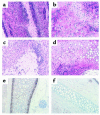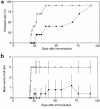A new animal model for relapsing polychondritis, induced by cartilage matrix protein (matrilin-1)
- PMID: 10487773
- PMCID: PMC408533
- DOI: 10.1172/JCI5740
A new animal model for relapsing polychondritis, induced by cartilage matrix protein (matrilin-1)
Abstract
Relapsing polychondritis (RP) differs from rheumatoid arthritis (RA) in that primarily cartilage outside diarthrodial joints is affected. The disease usually involves trachea, nose, and outer ears. To investigate whether the tissue distribution of RP may be explained by a specific immune response, we immunized rats with cartilage matrix protein (matrilin-1), a protein predominantly expressed in tracheal cartilage. After 2-3 weeks, some rats developed a severe inspiratory stridor. They had swollen noses and/or epistaxis, but showed neither joint nor outer ear affection. The inflammatory lesions involved chronic active erosions of cartilage. Female rats were more susceptible than males. The disease susceptibility was controlled by both MHC genes (f, l, d, and a haplotypes are high responders, and u, n, and c are resistant) and non-MHC genes (the LEW strain is susceptible; the DA strain is resistant). However, all strains mounted a pronounced IgG response to cartilage matrix protein. The initiation and effector phase of the laryngotracheal involvement causing the clinical symptoms were shown to depend on alphabeta T cells. Taken together, these results represent a novel model for RP: matrilin-1-induced RP. Our findings also suggest that different cartilage proteins are involved in pathogenic models of RP and RA.
Figures


Similar articles
-
Relapsing polychondritis, induced in mice with matrilin 1, is an antibody- and complement-dependent disease.Am J Pathol. 2004 Mar;164(3):959-66. doi: 10.1016/S0002-9440(10)63183-5. Am J Pathol. 2004. PMID: 14982849 Free PMC article.
-
Critical role of the major histocompatibility complex and IL-10 in matrilin-1-induced relapsing polychondritis in mice.Arthritis Res Ther. 2004;6(5):R484-91. doi: 10.1186/ar1218. Epub 2004 Aug 12. Arthritis Res Ther. 2004. PMID: 15380048 Free PMC article.
-
Cartilage-specific autoimmunity in animal models and clinical aspects in patients - focus on relapsing polychondritis.Arthritis Res. 2002;4(5):296-301. doi: 10.1186/ar425. Epub 2002 Jul 17. Arthritis Res. 2002. PMID: 12223103 Free PMC article. Review.
-
The occurrence of autoantibodies to matrilin 1 reflects a tissue-specific response to cartilage of the respiratory tract in patients with relapsing polychondritis.Arthritis Rheum. 2001 Oct;44(10):2402-12. doi: 10.1002/1529-0131(200110)44:10<2402::aid-art405>3.0.co;2-l. Arthritis Rheum. 2001. PMID: 11665983
-
Relapsing polychondritis: prospective study of 23 patients and a review of the literature.Medicine (Baltimore). 1976 May;55(3):193-215. Medicine (Baltimore). 1976. PMID: 775252 Review.
Cited by
-
Auricular chondritis in NOD.DQ8.Abetao (Ag7-/-) transgenic mice resembles human relapsing polychondritis.J Clin Invest. 2003 Dec;112(12):1843-50. doi: 10.1172/JCI17450. J Clin Invest. 2003. PMID: 14679179 Free PMC article.
-
Refractory relapsing polychondritis: challenges and solutions.Open Access Rheumatol. 2018 Jan 9;10:1-11. doi: 10.2147/OARRR.S142892. eCollection 2018. Open Access Rheumatol. 2018. PMID: 29391837 Free PMC article. Review.
-
Bilateral Anterior Uveitis Revealing Relapsing Polychondritis.Turk J Ophthalmol. 2019 Apr 30;49(2):99-101. doi: 10.4274/tjo.galenos.2018.28909. Turk J Ophthalmol. 2019. PMID: 31055895 Free PMC article.
-
Relapsing polychondritis, induced in mice with matrilin 1, is an antibody- and complement-dependent disease.Am J Pathol. 2004 Mar;164(3):959-66. doi: 10.1016/S0002-9440(10)63183-5. Am J Pathol. 2004. PMID: 14982849 Free PMC article.
-
Immunoregulatory defects of V alpha 24V+ beta 11+ NKT cells in development of Wegener's granulomatosis and relapsing polychondritis.Clin Exp Immunol. 2004 Jun;136(3):591-600. doi: 10.1111/j.1365-2249.2004.02471.x. Clin Exp Immunol. 2004. PMID: 15147365 Free PMC article.
References
-
- Foidart JM, et al. Antibodies to type II collagen in relapsing polychondritis. N Engl J Med. 1978;299:1203–1207. - PubMed
-
- Svenson KLG, et al. Cyclosporin A treatment in a case of relapsing polychondritis. Scand J Rheumatol. 1984;13:329–333. - PubMed
-
- Charrièra G, et al. Antibodies to type I, II, IX and XI collagen in serum of patients with rheumatic diseases. Arthritis Rheum. 1988;31:325–332. - PubMed
-
- Morgan K, et al. A longitudinal study of anticollagen antibodies in patients with rheumatoid arthritis. Arthritis Rheum. 1989;32:139–145. - PubMed
Publication types
MeSH terms
Substances
LinkOut - more resources
Full Text Sources
Other Literature Sources
Medical
Research Materials

